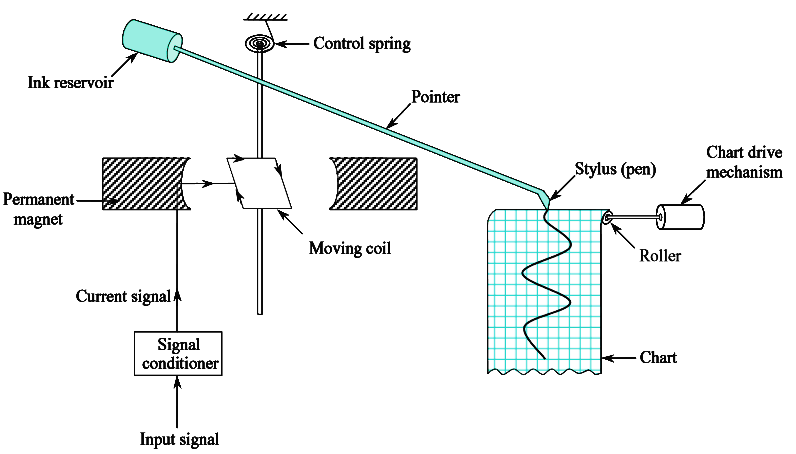
Figure 1: Galvanometer Type Recorder.
A galvanometer type recorder is a type of strip chart recorder and it is based on the principle of deflection i.e., the data is recorded due to deflection of pointer. The pointer deflects because of deflecting torque which is proportional to the magnitude of the variable being recorded.
Construction & Working of Galvanometer Type Recorder
The deflection of the stylus takes place with the help of a D’Arsonval galvanometer. In this type of recorder, the quantity to be recorded is first converted into a corresponding current signal using signal conditions and then applied to the moving coil of the galvanometer. The flow of current through moving coil in the presence of magnetic field of permanent magnet produces a torque on the coil due to which the coil rotates and the pointer attached to the coil gets deflected. Thus, the deflection of the pointer is directly proportional to the magnitude of the current flowing through the coil.
The stylus is attached to the pointer of the galvanometer so that the stylus gets deflected by an equal amount and in the same direction as that of deflection of the pointer. The schematic of a galvanometer type recorder is shown in the figure 1.
An ‘ink-filled stylus’ marking system is used in galvanometer type recorder. An ink reservoir is connected to the stylus (recording pen) through a narrow bore tube. The ink flows from the reservoir through the tube into the pen by capillary and gravity action. The graph paper is moved vertically downwards from a roll of graph paper at a uniform speed with the help of a chart drive mechanism. Thus, the deflection of the stylus over the rolling graph paper traces (records) the input signal waveform on the graph. The stylus comes to rest when the pointer is brought to rest by the controlling torque exerted by the control springs of the galvanometer.
Galvanometer recorders are used to record the signals of low frequency (usually, upto 100 Hz)